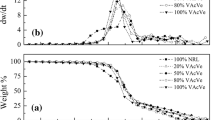Abstract
Poly(vinyl acetate) (PVAc) and natural rubber blends (NR) were prepared by low shear blending of the corresponding lattices. Thin films were cast using a doctor blade technique. SEM and DMA confirmed the essential immiscibility of the two polymers. Even when the poly(vinyl acetate) forms the matrix phase, it still contains domains encapsulated by a rubber phase where particles that resemble the original latex are visible. This incomplete droplet coalescence of the poly(vinyl acetate) is attributed to the fact that the rubber latex droplets were an order of magnitude smaller than the poly(vinyl acetate) latex droplets. Tensile testing revealed a nonlinear dependence of tensile strength and elongation on blend composition. Surprisingly good tensile yield strengths were obtained at intermediate to high PVAc contents. Thermogravimetric analysis of degradation in air and nitrogen atmospheres indicated independent degradation of the parent polymers.










Similar content being viewed by others
References
Paul DR, Sperling LH (1986) Adv Chem Ser 211:1
Gesner BD (1967) Polym Prepr (Am Chem Soc Div Polym Chem) 8:1482
Bergen RL Jr (1967) Polym Prepr (Am Chem Soc Div Polym Chem) 8:1473
Utracki LA, Weiss RA (1989) Multiphase Polymers, ACS Symp Ser 195:1
Dyson RW (1990) Engineering polymers. Chapman and Hall, New York, p 20
Chuu MS, Meyers RR (1987) J Appl Polym Sci 34:1447
Singh YP, Singh RP (1983) Eur Polym J 19:529
Brydson JA (1975) Plastics materials, 3rd edn. Newnes-Butterworths, London, p 317
Sivalingam G, Karthik R, Madras G (2004) Polym Degrad Stab 84:345
Sivalingam G, Karthik R, Madras G (2004) J Appl Polym Sci 93:1378
Gajria AM, Dave V, Gross RA, McCarthy SP (1996) Polymer 37:437
Mamza PAAP, Folaranmi FM (1996) Eur Polym J 32:909
Haiyang Y, Pingping Z, Feng R, Yuanyuan W, Tiao Z (2000) Eur Polym J 36:21
Qiao L, Easteal AJ (2001) Pigment Resin Technol 30:79
Vidovska D, Maurer FHJ (2006) Compos Interface 13:819
Winnik MA, Feng J (1996) J Coat Technol 68:39
Feng J, Winnik MA, Shivers RR, Clubb B (1995) Macromolecules 28:7671
Lepizzera S, Lhommeau C, Dilger G, Pith T, Lambla M (1997) J Polym Sci Part B: Polym Phys 35:2093
Robeson LM, Vratsanos MS (2000) Macromol Symp 155:117
Peng Z, Kong LX, Li S-D, Chen Y, Huang MF (2007) Compos Sci Technol 67:3130
Ibrahim A, Dahlan M (1998) Prog Polym Sci 23:665
Pizzi A (1983) Wood adhesives—chemistry and technology. Marcel Dekker, New York, p 328
Farris RJ (1968) Trans Soc Rheol 12:281
Brandrup J, Immergut EH (1989) Polymer handbook, 3rd edn. Wiley, New York
Young RJ (1981) Introduction to polymers. Chapman and Hall, London, p 206
Sivalingam G, Karthik R, Madras G (2003) Ind Eng Chem Res 42:3647
Acknowledgements
Financial support for this research from the Institutional Research Development Programme (IRDP) of the National Research Foundation (NRF), the University of the Free State and the University of Pretoria is gratefully acknowledged.
Author information
Authors and Affiliations
Corresponding author
Rights and permissions
About this article
Cite this article
Ochigbo, S.S., Luyt, A.S. & Focke, W.W. Latex derived blends of poly(vinyl acetate) and natural rubber: thermal and mechanical properties. J Mater Sci 44, 3248–3254 (2009). https://doi.org/10.1007/s10853-009-3435-6
Received:
Accepted:
Published:
Issue Date:
DOI: https://doi.org/10.1007/s10853-009-3435-6




